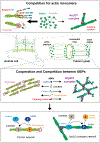F-Actin Cytoskeleton Network Self-Organization Through Competition and Cooperation
- PMID: 33021819
- PMCID: PMC8675537
- DOI: 10.1146/annurev-cellbio-032320-094706
F-Actin Cytoskeleton Network Self-Organization Through Competition and Cooperation
Abstract
Many fundamental cellular processes such as division, polarization, endocytosis, and motility require the assembly, maintenance, and disassembly of filamentous actin (F-actin) networks at specific locations and times within the cell. The particular function of each network is governed by F-actin organization, size, and density as well as by its dynamics. The distinct characteristics of different F-actin networks are determined through the coordinated actions of specific sets of actin-binding proteins (ABPs). Furthermore, a cell typically assembles and uses multiple F-actin networks simultaneously within a common cytoplasm, so these networks must self-organize from a common pool of shared globular actin (G-actin) monomers and overlapping sets of ABPs. Recent advances in multicolor imaging and analysis of ABPs and their associated F-actin networks in cells, as well as the development of sophisticated in vitro reconstitutions of networks with ensembles of ABPs, have allowed the field to start uncovering the underlying principles by which cells self-organize diverse F-actin networks to execute basic cellular functions.
Keywords: Arp2/3 complex; actin; formin; profilin; self-organization.
Figures


Similar articles
-
Profilin regulates F-actin network homeostasis by favoring formin over Arp2/3 complex.Dev Cell. 2015 Jan 12;32(1):43-53. doi: 10.1016/j.devcel.2014.10.027. Epub 2014 Dec 24. Dev Cell. 2015. PMID: 25543282 Free PMC article.
-
Arp2/3 complex- and formin-mediated actin cytoskeleton networks facilitate actin binding protein sorting in fission yeast.Eur J Cell Biol. 2024 Jun;103(2):151404. doi: 10.1016/j.ejcb.2024.151404. Epub 2024 Mar 16. Eur J Cell Biol. 2024. PMID: 38493594 Free PMC article.
-
Homeostatic actin cytoskeleton networks are regulated by assembly factor competition for monomers.Curr Biol. 2014 Mar 3;24(5):579-85. doi: 10.1016/j.cub.2014.01.072. Epub 2014 Feb 20. Curr Biol. 2014. PMID: 24560576 Free PMC article.
-
Exploring the Role of the Plant Actin Cytoskeleton: From Signaling to Cellular Functions.Int J Mol Sci. 2023 Oct 23;24(20):15480. doi: 10.3390/ijms242015480. Int J Mol Sci. 2023. PMID: 37895158 Free PMC article. Review.
-
Abp1p and cortactin, new "hand-holds" for actin.J Cell Biol. 2001 Aug 20;154(4):679-82. doi: 10.1083/jcb.200105061. J Cell Biol. 2001. PMID: 11514584 Free PMC article. Review.
Cited by
-
Molecular simulation approaches to probing the effects of mechanical forces in the actin cytoskeleton.Cytoskeleton (Hoboken). 2024 Aug;81(8):318-327. doi: 10.1002/cm.21837. Epub 2024 Feb 9. Cytoskeleton (Hoboken). 2024. PMID: 38334204 Free PMC article.
-
Cytosolic concentrations of actin binding proteins and the implications for in vivo F-actin turnover.J Cell Biol. 2023 Dec 4;222(12):e202306036. doi: 10.1083/jcb.202306036. Epub 2023 Oct 6. J Cell Biol. 2023. PMID: 37801069 Free PMC article.
-
Pleiotropic regulatory locus 1 maintains actin cytoskeleton integrity and cellular homeostasis to enable Arabidopsis root growth.iScience. 2024 Jun 28;27(8):110414. doi: 10.1016/j.isci.2024.110414. eCollection 2024 Aug 16. iScience. 2024. PMID: 39108734 Free PMC article.
-
Mechanism of the Pulvinus-Driven Leaf Movement: An Overview.Int J Mol Sci. 2024 Apr 23;25(9):4582. doi: 10.3390/ijms25094582. Int J Mol Sci. 2024. PMID: 38731801 Free PMC article. Review.
-
Mutant p53, the Mevalonate Pathway and the Tumor Microenvironment Regulate Tumor Response to Statin Therapy.Cancers (Basel). 2022 Jul 19;14(14):3500. doi: 10.3390/cancers14143500. Cancers (Basel). 2022. PMID: 35884561 Free PMC article. Review.
References
Publication types
MeSH terms
Substances
Grants and funding
LinkOut - more resources
Full Text Sources

